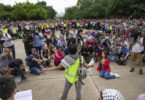Eyad Abu Shakra
There is a realistic Western saying: “Making a mistake once is an opportunity to learn from it, repeating it another time makes it an error, but doing it a third time … that’s idiotic.” This saying applies to all of our daily lives, but the world’s mightiest power repeatedly making the same mistake cannot be explained by stupidity. It must be intentional … even if it makes claims to the contrary.
Therefore, given the military situation we have reached in the Red Sea region, it is no longer sound to see things as US Secretary of State Antony Blinken or National Security Council Coordinator for Strategic Communications Rear Adm. John Kirby would like us to. Repeating a mistake – or let us say repeatedly being late to react – at such a high political level cannot possibly be a matter of stupidity. Rather, it is a strategic policy for which tasks are assigned, budgets are allocated and schedules are set.
Washington may have been “surprised” that bringing down Saddam Hussein’s regime, following the 2003 invasion, handed Iraq over to the clerics in Tehran and their Iranian Revolutionary Guards on a silver platter. I say “may have been surprised” because there are research centers, higher learning institutes and high-level, specialized experts in the US that provided the officials making decisions of war and peace with a clear picture of Iraq, its demographic composition, strategic location, regional and international hostilities and alliances, and the general balance of power in the Middle East and the Gulf, not to mention the sectarian and expansionist war launched by Tehran against the Arabs after 1979 under the banner of “exporting the Islamic Revolution.” Moreover, this “may” becomes more serious when we recall that Iran regularly topped the US State Department’s annual lists of “rogue states” and “state sponsors of terror.”
Moving on. Iraq was invaded, its rulers were overthrown and executed, and the new “people in charge” returned from their Iranian exile to take power and begin implementing Ayatollah Khomeini’s “export” plan. However, the picture should have become clear in Washington over the subsequent years in which Tehran’s subordinates dominated the Iraqi political scene, especially since their dominance was paralleled by the acceleration of Iran’s nuclear project and the expansion of the Revolutionary Guards’ field of intervention and sponsorship in countries neighboring Iraq, which “occupied,” in effect, from Bahrain and Kuwait to Syria and Lebanon, and even as far as Yemen.
Nevertheless, for some reason – possibly an American decision egged on by Israel – Washington, as well as Tel Aviv, chose to “coexist” with Iran’s regional ambitions. That decision contrasted with their keen determination to eliminate Iraq’s very early ambitions in this regard. This “coexistence,” which continues to this day, emerged despite the concerns of Arab countries in the region, including those that had explicitly warned, before the 2003 invasion, of Iran’s plan to “fill the vacuum” in Baghdad.
Later on, specifically after 2006, Hezbollah was left to impose its hegemony over Lebanon through the “innovative” formula developed by Western capitals, including Washington, of distinguishing between the political and military wings of the party that is ideologically, strategically and logistically linked to Tehran.
Then, under the pretext of the dubious emergence of Daesh, this coexistence continued and extended to Syria following the 2011 uprising. Again, Washington and Tel Aviv “acquiesced” to the status quo despite the regime in Damascus being on the same US State Department’s list of “rogue states” and “state sponsors of terrorism” as Tehran, as well as Iranian militias from different countries taking part in the fighting and then settling in Syria and the use of chemical weapons and barrel bombs in sectarian ethnic cleansing campaigns that claimed the lives of millions of civilians.
In the same vein, within two or three days of the operation on Oct. 7, Washington rushed to announce that it had “no evidence that Iran was involved” in what happened around the Gaza Strip, before changing its mind weeks later following the systematic destruction and horrific massacres that have claimed tens of thousands of lives over the past three months. Meanwhile, using its vast experience in political bargaining and security extortion, Tehran mobilized its militias in Iraq and Syria, along the Lebanese-Israeli border and, finally, in the Red Sea region.
The fact that various Hamas wings and a number of Palestinian factions are tied to Tehran was never a secret to the US administration. However, this state of affairs was acceptable so long as Palestinian divisions served Israel’s strategic interests and the “rules of engagement” were respected – as they are now in the “calibrated” skirmishes with Hezbollah across the border with Lebanon and in some locations in Syria.
Western capitals, especially Washington and London, were well aware of the reality on the ground but did nothing to protect international maritime trade routes. The truth is that what we are seeing, including the recent Anglo-American bombing of Yemen, is nothing more than “maneuver warfare,” through which the trajectory of the region is being negotiated. The main player is the US and the two regional parties benefiting most from the Arabs’ weakness are Israel and Iran. This “trajectory” was behind the decisions to invade Iraq in 2003, hand Lebanon over to Iran in 2006, protect the Damascus regime after 2011 and alter the nature of what remains of Palestine in the autumn of 2023.
Arab News







